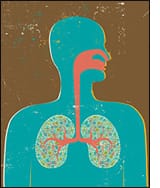The winter months are traditionally associated with an uptick in respiratory illnesses, but this year, public health experts are warning of a potentially severe situation as four significant viruses may circulate simultaneously. Dubbed a “quaddemic,” the combination of influenza, COVID-19, respiratory syncytial virus (RSV), and norovirus poses unique challenges for healthcare systems and communities alike. As these viruses begin to spread, understanding their current status and the implications for public health becomes increasingly crucial.
Influenza, commonly known as the flu, is a seasonal virus that typically peaks during the colder months. Health officials have noted an early start to flu season in several regions, with cases already rising. Symptoms of influenza include fever, cough, body aches, and fatigue, which can lead to more severe complications, especially in vulnerable populations such as the elderly and those with preexisting health conditions. Vaccination remains the primary defense against the flu, and health authorities are encouraging individuals to get their flu shots as soon as possible.
COVID-19, which has been a persistent global health concern since its emergence in late 2019, continues to evolve with new variants. While vaccination rates have increased and many people have developed some level of immunity, the virus still poses a risk, particularly during the winter months when indoor gatherings become more common. Experts are urging continued vigilance, including mask-wearing in crowded spaces and maintaining good hygiene practices, to mitigate the spread of COVID-19.
Respiratory syncytial virus (RSV) is another viral infection that primarily affects infants and young children, although it can also impact older adults. RSV is known for causing bronchiolitis and pneumonia, leading to hospitalizations in severe cases. Health officials have observed an increase in RSV cases in certain areas, prompting concerns about the potential for a surge as winter progresses. Parents are advised to monitor their children for symptoms such as wheezing, difficulty breathing, and persistent coughing, and to seek medical attention if these symptoms arise.
Norovirus, often referred to as the “stomach flu,” is a highly contagious virus that causes gastroenteritis, leading to symptoms such as vomiting, diarrhea, and abdominal pain. Outbreaks of norovirus are common in crowded environments, such as schools and nursing homes, especially during the winter months. Public health officials are emphasizing the importance of hand hygiene and proper food handling to prevent the spread of norovirus, as it can be transmitted through contaminated surfaces and food.
The convergence of these four viruses raises significant concerns for public health officials. Healthcare systems may face increased strain due to simultaneous outbreaks, leading to challenges in patient care and resource allocation. Hospitals may experience higher patient volumes, particularly in emergency departments, as individuals seek treatment for flu-like symptoms or gastrointestinal issues. This situation underscores the importance of vaccination and preventive measures to reduce the burden on healthcare facilities.
In response to the potential quaddemic, public health agencies are ramping up their surveillance efforts to monitor the spread of these viruses. Data collection and analysis will be essential in understanding the trajectory of the outbreaks and implementing appropriate public health interventions. Communities are encouraged to stay informed about local virus activity and adhere to public health guidelines to protect themselves and others.
As the winter months approach, it is essential for individuals to take proactive steps to safeguard their health. This includes receiving vaccinations for influenza and COVID-19, practicing good hygiene, and staying home when feeling unwell. Additionally, individuals should be aware of the symptoms associated with each virus and seek medical advice if they exhibit any concerning signs.
In conclusion, the potential for a quaddemic this winter, characterized by the simultaneous circulation of influenza, COVID-19, RSV, and norovirus, presents significant challenges for public health. With early signs of increased activity for these viruses, it is crucial for individuals and communities to remain vigilant and take preventive measures. By prioritizing vaccination, practicing good hygiene, and staying informed, it is possible to mitigate the impact of these viruses and protect public health during the winter season.



